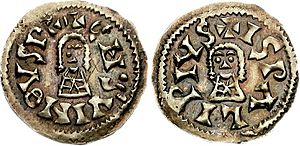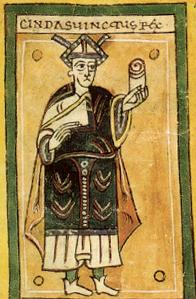Chindasuinth facts for kids
Quick facts for kids Chindasuinth |
|
|---|---|
| King of the Visigoths | |

A tremissis bearing a contemporary image of Chindasuinth
|
|
| Reign | 17 April 642 – 30 September 653 |
| Predecessor | Tulga |
| Successor | Recceswinth |
| Co-king | Recceswinth (20 January 649 – 30 September 653) |
| Born | c. 563 |
| Died | September 30, 653 (aged 89–90) |
| Burial | Monastery of San Román de Hornija |
| Wife | Recciberga |
| Religion | Chalcedonian Christianity |
Chindasuinth (born around 563, died September 30, 653) was a powerful Visigothic King who ruled Hispania (modern-day Spain and Portugal). He became king in 642 after taking the throne from the previous ruler, Tulga. The nobles chose him, and bishops officially approved him on April 30, 642. He was known for bringing peace and order to his kingdom.
Contents
Becoming King and His Rule
Chindasuinth was quite old when he became king, about 79 years old. He had a lot of experience from earlier wars and religious changes. He was a very strong ruler. People, including important church leaders and nobles, followed his rules. He made sure no one tried to rebel against him. He took action against those he thought might cause trouble. This helped him gain firm control over the kingdom.
Supporting the King's Power
In 646, a big meeting of church leaders, called the Seventh Council of Toledo, supported King Chindasuinth's actions. They agreed to make rules that would punish anyone who went against the king. These rules even applied to church members. By stopping all opposition, Chindasuinth brought a time of peace and order to his kingdom. This was something the region hadn't seen for a while.
Sharing Power with His Son
To make sure his rule continued, Chindasuinth made his son, Recceswinth, a co-king. This happened on January 20, 649. Chindasuinth hoped to start a family tradition where his son would take over after him. From then on, his son Recceswinth helped rule the Visigoths. He managed things for his father until Chindasuinth passed away in 653.

King Chindasuinth's Achievements
Even though he was a very strong political leader, Chindasuinth was also known for being generous to the church. He gave them land and special rights. He also improved the kingdom's finances. He used property taken from nobles who had opposed him. He also found better ways to collect taxes. In terms of military actions, he led campaigns against groups like the Basques and Lusitanians who were causing trouble.
Laws and Justice
Chindasuinth changed some laws about Jewish people. His predecessor, Tulga, had forced Jewish people to convert to Christianity or leave the country. Chindasuinth stopped these forced conversions. However, he did enforce laws that made it illegal for Christians to follow Jewish traditions. This was likely to prevent Christians from converting to Judaism.
He also created many new laws for everyday life. With the help of Braulio, a bishop from Zaragoza, he started to write a new set of laws for everyone in the kingdom. This new law book, called the Liber Iudiciorum, was first released in his second year as king. His son finished refining it in 654. This new code replaced older law books used by different groups of people in the kingdom.
Chindasuinth spent his final years doing religious acts. He asked Saint Fructuosus to build a monastery called San Román de Hornija. Chindasuinth planned for this monastery to be his burial place. His remains, along with his wife Riciberga's, are still there.
Legacy
Chindasuinth's oldest son, Recceswinth, became king after him. Recceswinth continued many of his father's important changes and improvements.
See also
 In Spanish: Chindasvinto para niños
In Spanish: Chindasvinto para niños

